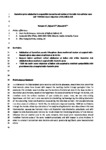Australian Plate Subduction is Responsible for Northward Motion of the India‐Asia Collision Zone and ∼1,000 km Lateral Migration of the Indian Slab
| dc.contributor.author | Parsons, Andrew | |
| dc.contributor.author | Sigloch, K | |
| dc.contributor.author | Hosseini, K | |
| dc.date.accessioned | 2021-10-19T12:39:19Z | |
| dc.date.available | 2021-10-19T12:39:19Z | |
| dc.date.issued | 2021-09-20 | |
| dc.identifier.issn | 0094-8276 | |
| dc.identifier.issn | 1944-8007 | |
| dc.identifier.other | ARTN e2021GL094904 | |
| dc.identifier.uri | http://hdl.handle.net/10026.1/18119 | |
| dc.description.abstract |
<jats:title>Abstract</jats:title><jats:p>Distributions of slabs within Earth's mantle are increasingly used to reconstruct past subduction zones, based on first‐order assumptions that slabs sink vertically after slab break‐off, and thus delineate paleo‐trench locations. Non‐vertical slab motions, which occur prior to break‐off, represent a potentially significant source of error for slab‐based plate reconstructions, but are poorly understood. We constrain lateral migration of the Indian slab and overlying India‐Asia collision zone by comparing tomographically imaged mantle structure with plate‐kinematic constraints. Following coupling of the Indian and Australian plates at the onset of collision, ∼1,000 km lateral migration of the Indian slab was driven by vertical subduction of the Australian slab. The sinking behaviors of individual slabs do not evolve in isolation, but instead influence, or are influenced by, other slabs in the same plate network. Hence, lateral slab migrations may be determined by interpreting the sinking behavior of slabs collectively, and with respect to plate kinematics.</jats:p> | |
| dc.language | en | |
| dc.language.iso | en | |
| dc.publisher | American Geophysical Union (AGU) | |
| dc.subject | plate tectonics | |
| dc.subject | subduction | |
| dc.subject | tomography | |
| dc.subject | India-Asia collision | |
| dc.subject | Tethys | |
| dc.subject | mantle | |
| dc.title | Australian Plate Subduction is Responsible for Northward Motion of the India‐Asia Collision Zone and ∼1,000 km Lateral Migration of the Indian Slab | |
| dc.type | journal-article | |
| dc.type | Journal Article | |
| plymouth.author-url | https://www.webofscience.com/api/gateway?GWVersion=2&SrcApp=PARTNER_APP&SrcAuth=LinksAMR&KeyUT=WOS:000703685100012&DestLinkType=FullRecord&DestApp=ALL_WOS&UsrCustomerID=11bb513d99f797142bcfeffcc58ea008 | |
| plymouth.issue | 18 | |
| plymouth.volume | 48 | |
| plymouth.publication-status | Published | |
| plymouth.journal | Geophysical Research Letters | |
| dc.identifier.doi | 10.1029/2021gl094904 | |
| plymouth.organisational-group | /Plymouth | |
| plymouth.organisational-group | /Plymouth/Faculty of Science and Engineering | |
| plymouth.organisational-group | /Plymouth/Faculty of Science and Engineering/School of Geography, Earth and Environmental Sciences | |
| plymouth.organisational-group | /Plymouth/Users by role | |
| plymouth.organisational-group | /Plymouth/Users by role/Academics | |
| dcterms.dateAccepted | 2021-08-26 | |
| dc.rights.embargodate | 2021-10-21 | |
| dc.identifier.eissn | 1944-8007 | |
| dc.rights.embargoperiod | Not known | |
| rioxxterms.versionofrecord | 10.1029/2021gl094904 | |
| rioxxterms.licenseref.uri | http://www.rioxx.net/licenses/all-rights-reserved | |
| rioxxterms.licenseref.startdate | 2021-09-20 | |
| rioxxterms.type | Journal Article/Review |


